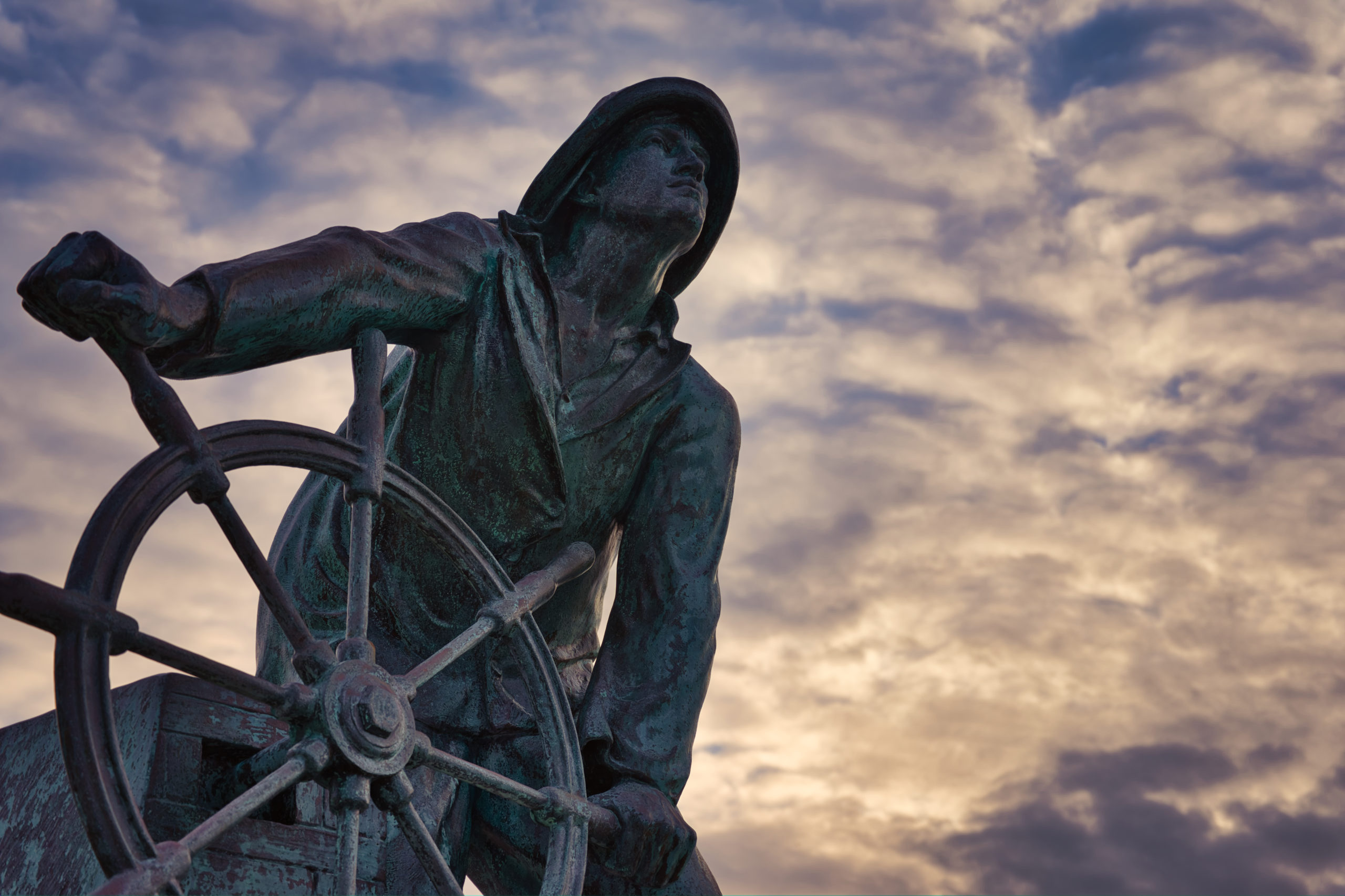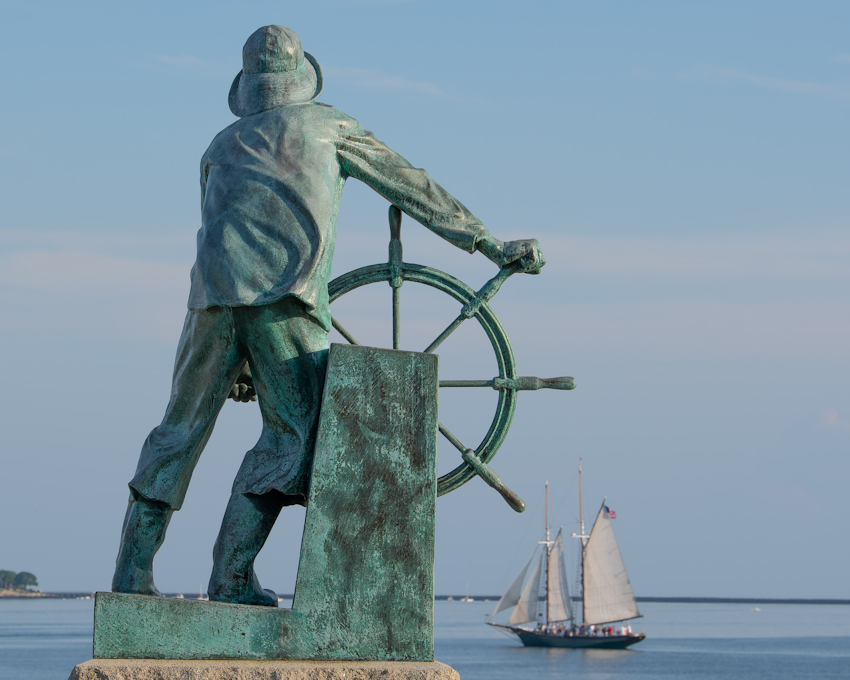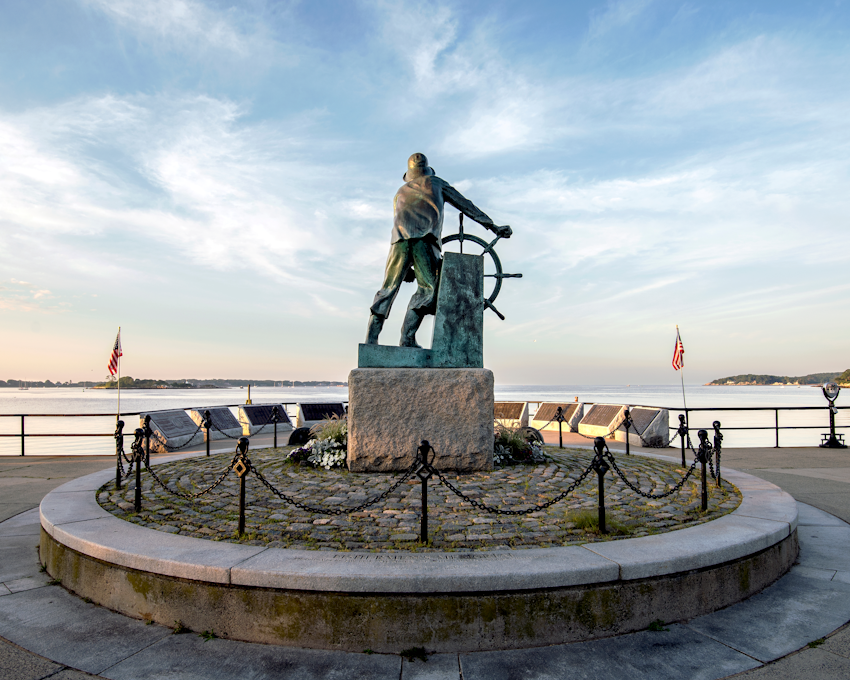Gloucester Fisherman’s Memorial History & Details

A Poignant Reminder of Life’s Fragility
In 2023 Gloucester celebrates the 400th Anniversary of its founding and the rich cultural traditions and history of America’s oldest fishing port. What better time to take a step back into Gloucester’s history and take a closer look at the Gloucester Fisherman’s Memorial statue, a fitting tribute to the brave men who sowed Gloucester’s maritime roots.
The Gloucester Fisherman’s Memorial was built to celebrate the city’s 300th anniversary and honor the lives of its many bold fishermen who were lost at sea. The memorial was erected in 1925 and depicts a steadfast fisherman at the wheel, eyes fixed on the horizon, bravely navigating through stormy seas.
The iconic bronze statue proudly stands 8’ tall and rests on a 5’ granite base, inside of which is a time capsule containing 47 items representing Gloucester history and culture in 1923.

The fisherman statue was modeled after a prominent Gloucester fisherman named Captain Clayton Morrisey, the captain of the Effie M. Morrisey. It was designed by English sculptor Leonard Craske and cast by the Gorham Company in Providence, Rhode Island.
Craske, a former medical student turned full-time artist, had recently emigrated to Boston and spent many hours sketching and photographing fishermen on local schooners in preparation for his masterpiece.
In addition to his research in the field, Craske also took inspiration from Rocky Neck artist Augustus Buhler’s (AW Buhler), 1901 painting “Man at the Wheel.” This AW Buhler painting was so beloved that Gorton-Pew purchased the painting and the copyright, using it as the starting point for the famous Gorton’s Fisherman logo.

The Man at the Wheel and the Gorton’s Fisherman are often confused by the public and it’s easy to see why when you realize that they share common inspiration in the work of AW Buhler. Above is an image of the two Gloucester icons side by side.
While estimates vary widely, it is assumed that approximately 10,000 lives have been lost at sea. Between 1860 to 1906, alone, an incredible 660 ships sank into the cold Atlantic waters.
One storm on February 24, 1862 claimed 15 schooners and 120 men. The gale force winds came quickly and unexpectedly upon a group of 70 schooners anchored out at George’s Bank. The mariners did not have time to run for deeper waters and the white out conditions resulted in a number of fatal collisions.
One of the deadliest fishing days in Gloucester history was in 1879 when 249 men lost their lives. To put the scale in perspective, that is more lives lost than there are active fishermen today in Gloucester.

To this day, commercial fishing remains one of the most dangerous occupations with a fatal injury rate of 55 in 100,000. The majority of deaths occur from falling overboard or being dragged overboard by gear.
In honor of those lost in this perilous profession, the base of the memorial is inscribed with a portion of Psalm 107:23 and states: “They that go down to the sea in ships” 1623-1923. The full text from the relevant portion of Psalm 107 is below:
They that go down to the sea in ships, that do business in great waters;
These see the works of the Lord, and his wonders in the deep.
For he commandeth, and raiseth the stormy wind, which lifteth
up the waves thereof.
They mount up to the heaven, they go down again to the
depths: their soul is melted because of trouble.
They reel to and fro, and stagger like a drunken man, and are
at their wit’s end.
Then they cry unto the Lord in their trouble, and he bringeth
them out of their distresses.
He maketh the storm a calm, so that the waves thereof are still.
Then are they glad because they be quiet; so he bringeth them
unto their desired haven.
Oh that men would praise the Lord for his goodness, and for
his wonderful works to the children of men!
Gloucester, MA is still an active fishing port and a quick drive down Rogers Street will reveal an active fleet and salty cast of characters. While overfishing and strict government regulations have made making a living more challenging, the waters are still filled with fish for both commercial and recreational fishing of all kinds.
The inner harbors of Cape Ann are filled with everyone’s favorite crustacean and you will see the lobster boats and buoys dotting the shores of Gloucester and Rockport. These pots provide fresh and tasty lobster for local institutions like Roy Moore’s Fish Shack in Rockport and Blue Collar Lobster in Gloucester.
Closer to shore you will find fish like striped bass, bluefish, mackerel, and flounder. If you’re looking to find some larger fish you can head out to the famous Stellwagen Bank to the south or Jeffrey’s Ledge to the North to track down haddock, halibut, cod, shark, black seabass or the grand daddy, bluefin tuna!
According to Fish & Game Marine Biologist, Kevin Sullivan, the ledges are like an underwater islands, a vast rise of 180-220 feet deep water in a surrounding sea of 400-feet depths. Fish congregate near the edges, where colder, nutrient-rich water wells up as it hits the drop-off. Schools of Atlantic herring, the primary food source for predacious groundfish, spawn on the ledges and follow the plankton rising to the surface in the water column.
For a even more rugged adventure, you can take the 150+ mile trek all the way out to Georges Bank. St Georges Bank is considered one of the most important fishing ground on the coastal United States, second only to Grand Bank off the coast of Newfoundland.
When reading through the names of Gloucester fishermen lost at sea there are many who lost their lives heading to and from Georges Bank.
For a closer look at some incredible images of Gloucester fishermen from back in the golden era of fishing, you have to take a look at these images from the Library of Congress below. They are absolutely beautiful images that truly capture the spirit of the day:
The Gloucester Fisherman’s Memorial is located on Stacy Boulevard in Gloucester, just off of Western Ave near the Harborview Inn. If you type the memorial into navigation it should pop right up. You can park right along the street on Western Ave.
Hopefully, that provides some interesting context for the Gloucester Fisherman’s Memorial. Next time our team here at Addison Choate is enjoying some fish here on Cape Ann, we will definitely take a moment to appreciate the history of the fishing industry in Gloucester and the efforts taken to acquire the tasty bounty.